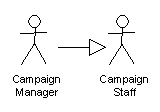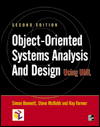 |
1 |  | 
Which of the following is not a reason for analysing the current system (if it exists)? |
|  | A) | The analyst needs to know about problems with and defects in the current system. |
|  | B) | The analyst must not lose sight of his or her objectives. |
|  | C) | Much of the functionality of the existing system will be required in the new system. |
 |
 |
2 |  | 
Which of the following is not an example of a functional requirement? |
|  | A) | Security considerations. |
|  | B) | Details of data that must be held in the system. |
|  | C) | Descriptions of the processing that the system will be required to carry out. |
 |
 |
3 |  | 
Which of the following describes a functional requirement. |
|  | A) | The system must be capable of responding to all queries within 5 seconds. |
|  | B) | Users of the system will make 50% fewer errors than with the existing system. |
|  | C) | The system must allow users to enter details of advertising campaigns. |
 |
 |
4 |  | 
Which of the following is not an example of a non-functional requirement? |
|  | A) | Volume of data. |
|  | B) | Performance requirements. |
|  | C) | The content of printed reports required from the system. |
 |
 |
5 |  | 
Which of the following describes a non-functional requirement? |
|  | A) | The system must be capable of holding 500Mb of data initially, growing by 100Mb per year. |
|  | B) | The system must produce a report of all advertising campaigns for a particular client. |
|  | C) | The system must allow users to enter details of clients. |
 |
 |
6 |  | 
Which of the following is not the kind of information gathered to understand usability requirements? |
|  | A) | The characteristics of the users of the system. |
|  | B) | The context in which the system will be used. |
|  | C) | The volume of data in the existing system. |
 |
 |
7 |  | 
Which of the following lists only contains systems analysis fact-finding techniques? |
|  | A) | Sampling, questionnaires, interviewing, reading and observation. |
|  | B) | Use case modelling, interviewing, class diagramming, observation and knowledge acquisition. |
|  | C) | Sampling, background reading, interviewing, use case modelling and activity diagramming. |
 |
 |
8 |  | 
Which fact-finding technique is most suitable to be used in the initial stages of fact-finding and particularly where the analyst is not familiar with the organization that is being studied? |
|  | A) | Background reading. |
|  | B) | Interviewing. |
|  | C) | Questionnaires. |
 |
 |
9 |  | 
Which of the following is a valid reason for using interviewing as a fact-finding technique? |
|  | A) | The interviewer can gather statistical data about documents. |
|  | B) | The interviewer can respond flexibly to the interviewee’s responses. |
|  | C) | Interviews take very little time. |
 |
 |
10 |  | 
In which of the following circumstances is it not appropriate to use questionnaires? |
|  | A) | The views and knowledge of a large number of people must be obtained. |
|  | B) | The people who work for the organization are geographically dispersed. |
|  | C) | There is a need to check how people actually carry out their work. |
 |
 |
11 |  | 
Which of the following categories of people are not likely to be involved in a steering committee? |
|  | A) | Senior managers. |
|  | B) | System testers. |
|  | C) | Representatives of users. |
 |
 |
12 |  | 
Which of the following does the figure below show?  <a onClick="window.open('/olcweb/cgi/pluginpop.cgi?it=gif::Fig. 6.12::/sites/dl/free/0077098641/41598/ch06_q12_q.gif','popWin', 'width=195,height=142,resizable,scrollbars');" href="#"><img valign="absmiddle" height="16" width="16" border="0" src="/olcweb/styles/shared/linkicons/image.gif">Fig. 6.12 (50.0K)</a> <a onClick="window.open('/olcweb/cgi/pluginpop.cgi?it=gif::Fig. 6.12::/sites/dl/free/0077098641/41598/ch06_q12_q.gif','popWin', 'width=195,height=142,resizable,scrollbars');" href="#"><img valign="absmiddle" height="16" width="16" border="0" src="/olcweb/styles/shared/linkicons/image.gif">Fig. 6.12 (50.0K)</a>
Fig. 6.12
|
|  | A) | An actor. |
|  | B) | A use case |
|  | C) | An activity |
 |
 |
13 |  | 
Which of the following does the figure below show?  <a onClick="window.open('/olcweb/cgi/pluginpop.cgi?it=gif::Fig. 6.13::/sites/dl/free/0077098641/41598/ch06_q13_q.gif','popWin', 'width=113,height=164,resizable,scrollbars');" href="#"><img valign="absmiddle" height="16" width="16" border="0" src="/olcweb/styles/shared/linkicons/image.gif">Fig. 6.13 (50.0K)</a> <a onClick="window.open('/olcweb/cgi/pluginpop.cgi?it=gif::Fig. 6.13::/sites/dl/free/0077098641/41598/ch06_q13_q.gif','popWin', 'width=113,height=164,resizable,scrollbars');" href="#"><img valign="absmiddle" height="16" width="16" border="0" src="/olcweb/styles/shared/linkicons/image.gif">Fig. 6.13 (50.0K)</a>
Fig. 6.13
|
|  | A) | An actor. |
|  | B) | A use case. |
|  | C) | A user. |
 |
 |
14 |  | 
Which of the following is not a purpose for using use cases? |
|  | A) | To document the scope of the system. |
|  | B) | To provide a high-level view of system functionality from the users’ perspective. |
|  | C) | To describe the logic of operations. |
 |
 |
15 |  | 
Which of the following pairs lists valid dependencies to show on a use case diagram? |
|  | A) | «extend» and «include». |
|  | B) | «extend» and «retract». |
|  | C) | «exclude» and «include». |
 |
 |
16 |  | 
Which of the following is the correct name for the symbols placed round stereotyped names such as «extend»? |
|  | A) | Guillemots. |
|  | B) | Parakeets. |
|  | C) | Guillemets. |
 |
 |
17 |  | 
Which of the following describes the figure below?  <a onClick="window.open('/olcweb/cgi/pluginpop.cgi?it=gif::Fig. 6.17::/sites/dl/free/0077098641/41598/ch06_q17_q.gif','popWin', 'width=227,height=282,resizable,scrollbars');" href="#"><img valign="absmiddle" height="16" width="16" border="0" src="/olcweb/styles/shared/linkicons/image.gif">Fig. 6.17 (50.0K)</a> <a onClick="window.open('/olcweb/cgi/pluginpop.cgi?it=gif::Fig. 6.17::/sites/dl/free/0077098641/41598/ch06_q17_q.gif','popWin', 'width=227,height=282,resizable,scrollbars');" href="#"><img valign="absmiddle" height="16" width="16" border="0" src="/olcweb/styles/shared/linkicons/image.gif">Fig. 6.17 (50.0K)</a>
Fig. 6.17
|
|  | A) | Check campaign budget extends Print campaign summary. |
|  | B) | Check campaign budget includes Print campaign summary. |
|  | C) | Print campaign summary extends Check campaign budget. |
 |
 |
18 |  | 
Which of the following statements is true? |
|  | A) | Actors are linked to use cases by inheritance. |
|  | B) | Actors are linked to use cases by communication associations. |
|  | C) | Actors are linked to use cases by «uses» dependencies. |
 |
 |
19 |  | 
Which of the following is shown in a use case diagram by a rectangle surrounding a group of use cases? |
|  | A) | The class that implements the use cases. |
|  | B) | The system or sub-system that the use cases belong to. |
|  | C) | The package that contains the use cases. |
 |
 |
20 |  | 
Which of the following is the best definition of an actor? |
|  | A) | An actor represents a user of the system. |
|  | B) | An actor represents a role played by a user of the system. |
|  | C) | An actor represents a role played by a user of the system or by an external system. |
 |
 |
21 |  | 
Which of the following is true? |
|  | A) | An Extend dependency means that the functionality of one use case optionally extends the functionality of another at a particular point or points in its execution. |
|  | B) | An Extend dependency means that the functionality of one use case always extends the functionality of another at a particular point or points in its execution. |
|  | C) | An Extend dependency means that the functionality of one use case inherits the functionality of another at a particular point or points in its execution. |
 |
 |
22 |  | 
Which of the following is true? |
|  | A) | An Include dependency means that the functionality of one use case optionally includes the functionality of another at a particular point or points in its execution. |
|  | B) | An Include dependency means that the functionality of one use case always includes the functionality of another at a particular point or points in its execution. |
|  | C) | An Include dependency means that the functionality of one use case inherits the functionality of another at a particular point or points in its execution. |
 |
 |
23 |  | 
What is shown in the following diagram?  <a onClick="window.open('/olcweb/cgi/pluginpop.cgi?it=gif::Fig. 6.23::/sites/dl/free/0077098641/41598/ch06_q23-24_q.gif','popWin', 'width=210,height=182,resizable,scrollbars');" href="#"><img valign="absmiddle" height="16" width="16" border="0" src="/olcweb/styles/shared/linkicons/image.gif">Fig. 6.23 (50.0K)</a> <a onClick="window.open('/olcweb/cgi/pluginpop.cgi?it=gif::Fig. 6.23::/sites/dl/free/0077098641/41598/ch06_q23-24_q.gif','popWin', 'width=210,height=182,resizable,scrollbars');" href="#"><img valign="absmiddle" height="16" width="16" border="0" src="/olcweb/styles/shared/linkicons/image.gif">Fig. 6.23 (50.0K)</a>
Fig. 6.23
|
|  | A) | A data flow from one actor to another. |
|  | B) | An inheritance relationship between two actors. |
|  | C) | An Extend dependency between two actors. |
 |
 |
24 |  | 
Which of the following is true based on the diagram below?  <a onClick="window.open('/olcweb/cgi/pluginpop.cgi?it=gif::Fig. 6.24::/sites/dl/free/0077098641/41598/ch06_q23-24_q.gif','popWin', 'width=210,height=182,resizable,scrollbars');" href="#"><img valign="absmiddle" height="16" width="16" border="0" src="/olcweb/styles/shared/linkicons/image.gif">Fig. 6.24 (50.0K)</a> <a onClick="window.open('/olcweb/cgi/pluginpop.cgi?it=gif::Fig. 6.24::/sites/dl/free/0077098641/41598/ch06_q23-24_q.gif','popWin', 'width=210,height=182,resizable,scrollbars');" href="#"><img valign="absmiddle" height="16" width="16" border="0" src="/olcweb/styles/shared/linkicons/image.gif">Fig. 6.24 (50.0K)</a>
Fig. 6.24
|
|  | A) | Campaign Manager can use the same use cases as a Campaign Staff and one or more additional ones. |
|  | B) | Campaign Staff can use the same use cases as a Campaign Manager and one or more additional ones. |
|  | C) | Only Campaign Manager actors exist, as Campaign Staff is an abstract actor. |
 |
 |
25 |  | 
Which of the following is the term for a textual description of a use case? |
|  | A) | Behaviour description. |
|  | B) | Use case activity. |
|  | C) | Use case description. |
 |
 |
26 |  | 
Which of the following is not a reason for using prototyping during use case development? |
|  | A) | To clarify requirements. |
|  | B) | To test the architecture of architecturally significant use cases. |
|  | C) | To get the user interface development started before the class diagramming is begun. |
 |
 |
27 |  | 
Which of the following is true? |
|  | A) | Business use cases are shown in grey. |
|  | B) | Business use cases show actors outside the organization interacting with the organization. |
|  | C) | Business use cases are always produced after ordinary use cases have been produced. |
 |




 2002 A McGraw-Hill Online Learning Centre
2002 A McGraw-Hill Online Learning Centre